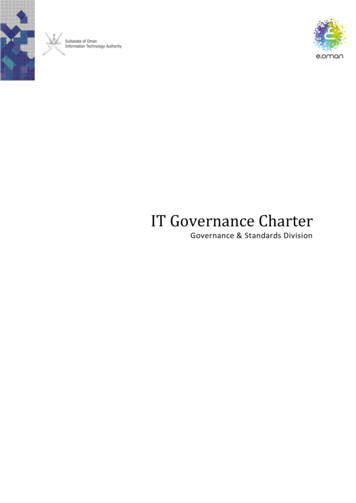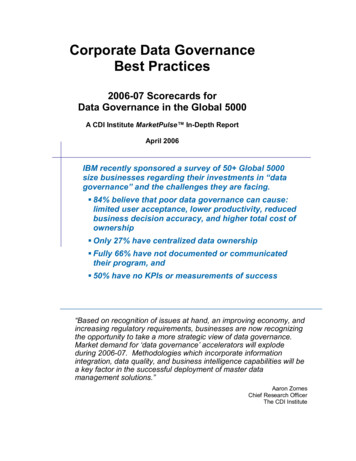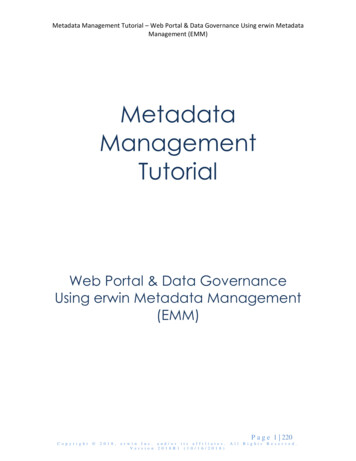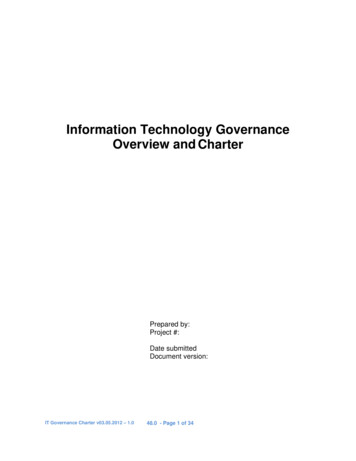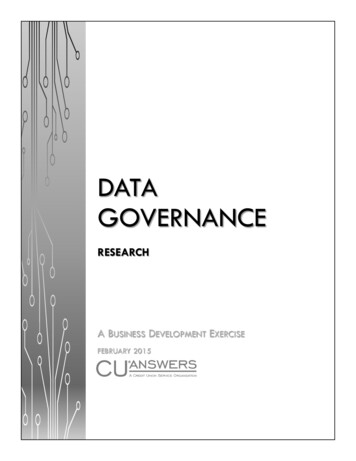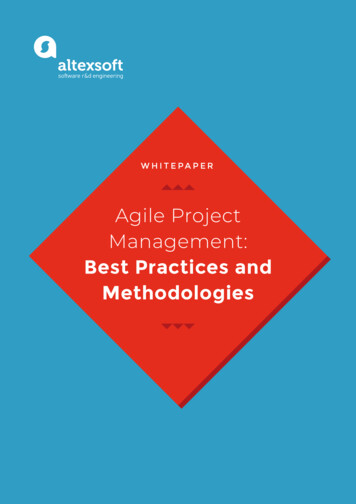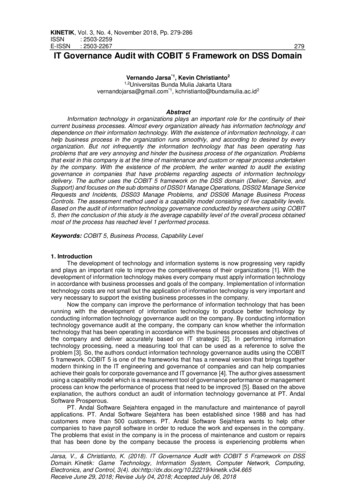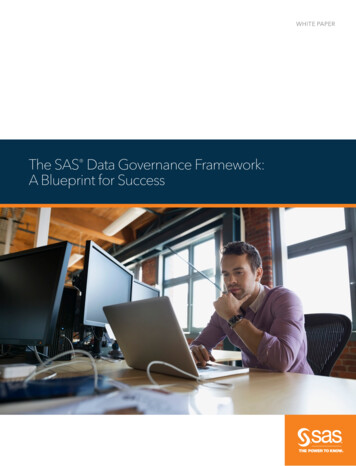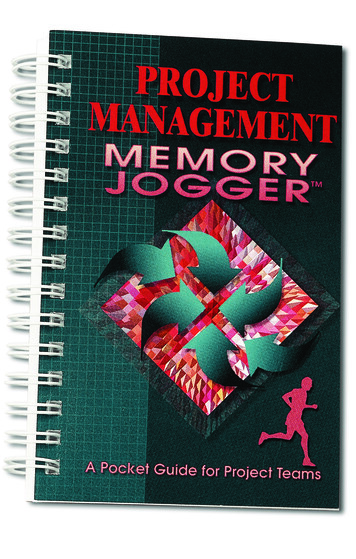
Transcription
IMPROVINGTHEWAY ORGANIZATIONS RUN
PROJECTMANAGEMENTMEMORYJOGGER A Pocket Guide for Project TeamsPaula MartinandKaren Tate, PMPMartin Tate, LLCGOAL/QPCPMMJ Intro112/3/03, 10:36 AM
Project Management Memory Jogger 1997 by GOAL/QPC. All rights reserved.Reproduction of any part ofthis publication without the writtenpermission of GOAL/QPC is prohibited.Development TeamPaula Martin, AuthorKaren Tate, AuthorMichael Brassard, Content DeveloperDorie Overhoff, Project Manager & MarketingFran Oddo, EditorMichele Kierstead, Cover & Book DesignSue Griebel, ProofreaderLisa Gilliland, MarketingBob Page, MarketingStan Marsh, Product Team SponsorRichard Morrison, MarketingGOAL/QPC12B Manor Parkway, Salem, NH 03079-2862Toll free: 800-643-4316 or 603-890-8800Fax: 603-870-9122E-mail: service@goalqpc.comWeb site: www.goalqpc.comPrinted in the United States of AmericaFirst Edition10 9 8ISBN 1-57681-001-1PMMJ Intro212/3/03, 10:36 AM
How to Use this BookThis pocket guide provides a variety of examples, visualcues, design features, and clear, friendly language thatwe hope will encourage project teams everywhere touse this book, and use it often! Everyone on a projectteam can use this book as a daily reference on the joband/or as a supplement to training. Have fun!To Find a TopicUse the contents page at the front of the book, or thechart at the beginning of every chapter (shown below).When you need to . . .Do thisactivityPage#To Find the Start of Each ChapterLook for the blue box at the bottom of the page.To See at a Glance What Activities Mustbe Done for Your ProjectFirst determine the type of project you have. (See page 7for the distinctions between projects.) Next, look for thekey icons that match your project type. Skip the activitiesthat don’t show the correct key icon for your project.ALLONLYONLY21 2 33projectprojectproject3typestypes 2 & 3type 3To Find Tips & PitfallsLook for this icon:To Find Each Piece of the Case Study thatis Illustrated Through the BookLook for the flipchart pad or other graphics thathave a graph paper fill in them.ivPMMJ Intro412/3/03, 10:36 AM
ContentsHow to Use this Book . ivLeadership Summary . vii12PMMJ IntroCreating Successful Projects . 1Know the GeographyWhat is a project? . 1What is a successful project? . 2What is project management? . 2How does project management help projectteams? . 3Plan the JourneyA legend of key terms . 4Who will be making the journey? . 5Which route will the team take? . 7What are the important landmarks for yourteam’s journey? . 8A project roadmap . 9Project management at a glance . 10How to Create a Project Charter . 11Write an Overview of the Project Scope . 13Determine the Team’s Boundaries forCreating the Deliverables . 18Define Customers’ Criteria for Acceptance . 21Determine Required Reviews & Approvals . 22Establish Risk Limits . 24Select the Project Leader & Team Members . 26Set Deadlines for Delivery of the FinalDeliverables . 28Set Limits on Staffing & Spending . 30Create a List of Required Reports . 32Identify Organizational Constraints& Project Priorities . 34Assemble the Project Charter . 37512/3/03, 10:36 AM
3456How to Work Together as a Team . 43Commit to the Project . 44Develop Team Ground Rules . 45Determine Meeting Guidelines . 47Create a “Parking Lot” . 49Create an Issues List . 50How to Create a Project Plan . 51Define the Project Scope . 53Complete the List of Required Reviews &Approvals . 69Assess the Risks Connected with theProject Scope . 73Complete the List of RequiredProject Status Reports . 78Review Team Membership . 82Create a Project Schedule . 88Estimate the Staff Effort Required . 112Create a Project Budget . 121Assemble the Project Plan . 130Doing the Project . 135Monitor Project Progress . 136Resolve Problems and Manage Change . 141Hold Project Team Meetings . 146Hold Project Review Meetings . 150How to Close Out the Project . 153Hold a Feedback Meeting with Customers . 154Hold a Team Meeting to DevelopLessons Learned . 157Hold a Project Review Meeting withthe Sponsor . 161Create the Close-out Report . 162Recommended Activities for the Project Types . 166Tool Application Chart . 168About this Book/About the Authors . 171Index . 173PMMJ Intro612/3/03, 10:36 AM
Leadership SummaryWhy do organizations need projectmanagement?Project management: ensures that customer requirements are met. eliminates “reinventing the wheel” bystandardizing routine project work. reduces the number of tasks that could beoverlooked during the project. eliminates duplication of effort. ensures that projects are in control. maximizes the use of resources.What is involved in the projectmanagement process? A decision is made to launch a project. A charter is prepared, which outlines therequirements and limitations of the project. Thecharter is usually written by the sponsor incollaboration with either the project leader or themanagement steering group. The charter is discussed with the project team anddistributed to management and key projectstakeholders. The project plan is drafted by the project team,approved by the sponsor, and distributed tomanagement and key stakeholders. The plan is executed and monitored, and the finaldeliverables, i.e., a product, service, process, orplan, are delivered to the project customers. The project is evaluated and a close-out report iswritten and distributed to management and keystakeholders.viiPMMJ Intro712/3/03, 10:36 AM
Who Has Project Accountability?Personor groupIs accountable for:Senior Ensuring that the organization has aManagementproject management process thatproject teams can follow. Providing the resources to supportselected projects.FunctionalManager Providing resources from his or her areato support the project. Supporting the project objectives.Sponsor Ensuring that the project has cleardirection and support. Providing a charter to the project team. Ensuring that the project plan meetsboth the customers’ needs and theorganization’s needs.TeamLeader Ensuring that the project satisfies boththe customer and the organization. Ensuring that the project is completedon time and within the project’s limitsand constraints.TeamMember Ensuring that his or her part of theproject work satisfies the needs of theproject and is completed on time andwithin budget.viiiPMMJ Intro812/3/03, 10:36 AM
ProjecConfet MgmtrenceChapter 1Creating SuccessfulProjectsKnow the GeographyWhether you’ve been on a hundred journeys with projectteams or you’re a first time traveler, you and your teamneed a common understanding of what the terrain willlook like when you get involved in projects and projectmanagement. This understanding will help your teamstay on the most direct route to your destination.What is a project?A project is any temporary, organized effort that createsa unique product, service, process, or plan. It can be assimple as the plan for an off-site retreat or as complex asthe construction of a medical center, with a team sizeranging from a few people to hundreds or even thousandswho are working in one location or across continents.Projects bring together people from a range of jobs andprovide them with the opportunity to collaborate in aunique way. Because projects are so diverse and flexible,organizations have increasingly used them as thepreferred way to fulfill the needs of their customers.A legend of key termsPage4Identify your project type7Project management at a glance10Creating Successful Projects 1997 GOAL/QPCPMMJ Chapter11112/3/03, 10:42 AM
A Project RoadmapCreating theProject CharterP roj e c tNNWEWorkingas a TeamS12NEWS Team membercommitmentsclarified Team/meetingguidelinesdeveloped123C3nfe r e nrhapteCoceuAre HeerYo The “big picture” scope defined The project limits drawn4Developingthe Project Plan5 Details added to the project scope Project boundaries determined Schedule, budget and staffingestimates created Risk factors andcountermeasures definedDoing the Project Project progressmonitored ChangemanagedecPr oj t Cereon fe n c6Closing Out the Project Customer satisfaction evaluated Lessons learned capturedCreating Successful Projects 1997 GOAL/QPCPMMJ Chapter19912/3/03, 10:42 AM
The conference attendees are the customersof the 3-day conference on project management.4. Define the customers’ needs and requirements. Determine what problem the customer wants tosolve by using a specific final deliverable.(Customer need.) Find out if the customer is looking for specificfeatures in the final deliverable, or has definedspecifications for the final deliverable. (Customerrequirement.)The sponsor may not know what the needs andrequirements of the customer are, so the sponsormay delegate this task to the project team.Project Scope OverviewProject name: 3-day conference on projectmanagementCustomers’ needs:1) Increase knowledge and skill to bettermanage projects.2) Make contacts with other people who arepracticing project management.One of the customers’ requirements: Thesessions should address all levels of projectmanagement expertise.14PMMJ Chapter2Write Scope Overview14 1997 GOAL/QPC12/3/03, 10:55 AM
5. Identify and list the final deliverables of theproject. A final deliverable:– Is a product, service, process, or plan.– Must satisfy customer needs and requirements.– Is delivered to the customers of the project. A project usually has only one or two major finaldeliverables.If there are some options in which finaldeliverable will best satisfy the customers’needs and requirements, instruct the team todetermine, with the customer if possible, thefinal deliverable of choice.If a project team will be producing a productand a process for delivering the product, theactivities that must be completed to produce theproduct will be different from those for producingthe process. The product and process (for deliveringthe product) are two different final deliverables.Final deliverable: the 3-day conference onproject managementHow to Create a Project Charter 1997 GOAL/QPCPMMJ Chapter2151512/3/03, 10:55 AM
Assess the Risk inProducing the Final Deliverables123Why do it?To inform the sponsor, and the customer whenappropriate, of the degree of risk connected with theproject scope, and the countermeasures that the teamhas developed, if needed, to bring the risks down tolevels that are acceptable to the organization.How do I do it?1. Assign a risk rating to the team’s ability to produceeach final deliverable. List the reasons and assumptions for the risk rating assigned by the team. Use a scale from 1–10 to assign the risk rating,with 10 as the highest risk, and 1 as the lowest. A low risk rating (1–3) means there is a low degreeof risk or uncertainty involved in producing thefinal deliverable according to the customer’scriteria for acceptance. A moderate risk rating (4–7) means there is amoderate degree of risk or uncertainty involvedin producing the final deliverable according tothe customer’s criteria for acceptance. A high risk rating (8–10) means there is a highdegree of risk or uncertainty involved inproducing the final deliverable according to thecustomer’s criteria for acceptance.Rating Scale1234Low riskLow uncertainty74PMMJ Chapter4567Moderate riskModerate uncertaintyAssess the Risk748910High riskHigh uncertainty 1997 GOAL/QPC12/3/03, 11:22 AM
The team should assess its capability to producethe final deliverables of the project. In makingthis assessment, the team does not need toconsider whether or not the resources (time,people, money) needed to produce the finaldeliverables will be available.2. Compare the team’s risk rating to the limit definedin the charter. For each final deliverable that has arisk rating above the limit, create countermeasuresto bring the risk down to the limit. Brainstorm possible countermeasures that willreduce the risk. One method for identifying risksand countermeasures is to use a PDPC (ProcessDecision Program Chart). Consult The MemoryJogger II, pages 160–162, for instructions on howto use this tool. From the brainstormed list of countermeasures,select those that will bring the team’s risk ratingdown to the limit. If a limit was not set by thesponsor, bring the risk rating down to a level thatis acceptable to the team or get clarification fromthe sponsor on what the acceptable level of riskshould be for each final deliverable. If the team cannot bring the risk rating down tothe limit, this issue should be added to the issueslist and the project leader should resolve it withthe sponsor.If there is a way to bring the risk rating down to alevel lower than the sponsor’s limit—withoutadding costs such as time, money, or effort—theteam should go ahead and do it. However, ifadditional costs would be involved, the team shouldput the additional countermeasure(s) on the issueslist and then discuss them with the sponsor.How to Create a Project Plan 1997 GOAL/QPCPMMJ Chapter4757512/3/03, 11:22 AM
PROJECT MANAGEMENT MEMORY JOGGER A Pocket Guide for Project Teams Paula Martin and Karen Tate, PMP

